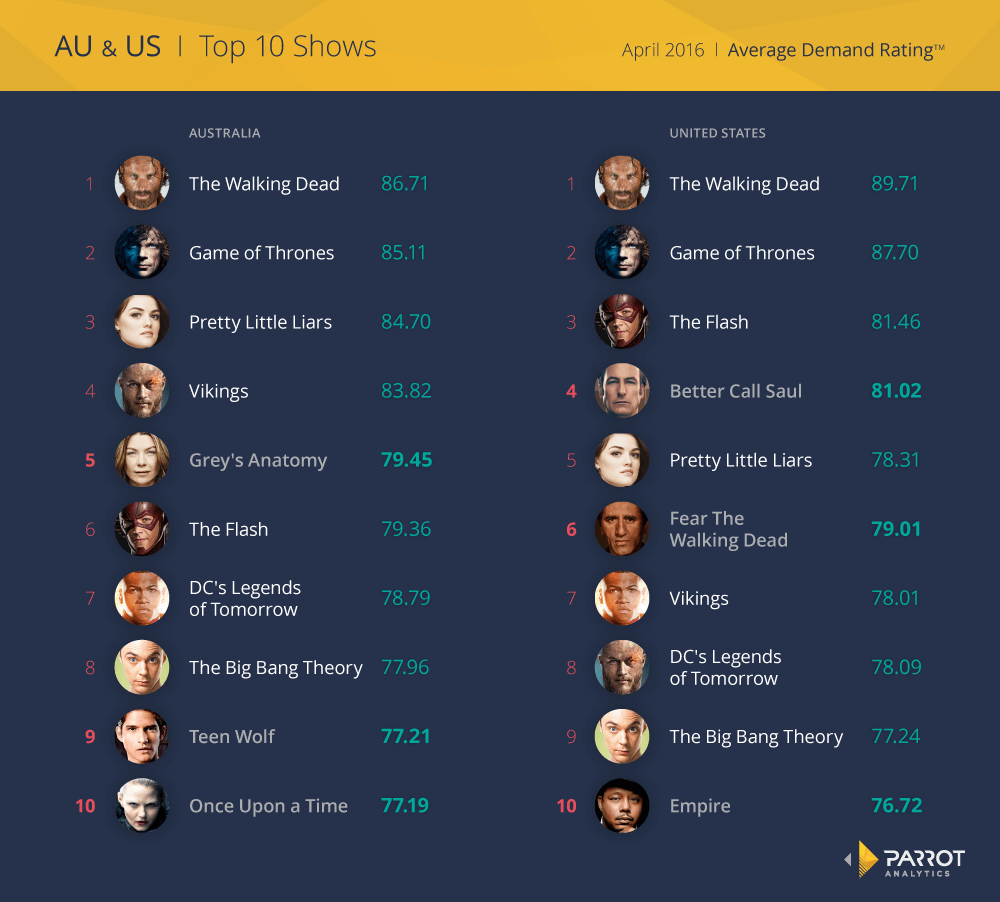This week we focus on a specific market, Australia, and the most popular shows and genres in this country. In order to provide context to the results, we compare them to the results from the United States, the largest market for TV content. In this way, critical differences are revealed between two markets that many believe are similar.
First, the top ten shows in both Australia and the United States are found by averaging each title’s Demand Rating™ from April 1st to April 30th.

Australia and the United States have similar tastes at the top, as seven titles out of the top ten are the same in both markets. Instead of the dramas Better Call Saul, Fear the Walking Dead, and Empire, Australia prefers lighter shows Grey’s Anatomy (rank 20 in the US), Teen Wolf (rank 11 in the US), and Once Upon a Time (rank 13 in the US).
Out of the titles that appear in both top ten lists, Australia has higher demand for Pretty Little Liars, Vikings, DC’s Legends of Tomorrow (though it is rank 7 in both markets), and The Big Bang Theory than the United States. In fact, the US only has higher demand than Australia for its top three titles: The Walking Dead, Game of Thrones, and The Flash. This result indicates that except for the very top-tier shows, Australia has more demand for many titles than these titles’ home market.
Instead of the top titles overall, we next look at the top five digital original series in each market, with their overall ranking listed, to determine if these titles reveal more differences between the markets.

Compared to the overall top ten shows, the top digital originals are more different: only Netflix’s House of Cards and Hulu’s 11.22.63 appear on both lists. The United States’ top five shows are all recent releases, but Australia has more demand for older titles such as Making a Murderer and Orange is the New Black. The relative age of Australia’s top five digital originals may explain why the average rank of these shows is lower (rank 49) than the average rank of the US’s top digital originals (rank 37). Unlike the overall top shows, where Australia had more demand in many cases, the United States has more demand for its own digital originals. The result suggests that the Australian market still prefers linear TV shows to SVOD titles.
Since the top titles, both overall and digital originals, are similar in both markets, we next consider the top 100 titles grouped by genre in both markets to uncover more general trends in these markets. Instead of aggregating by the sum of Demand Expressions™, which would skew the results towards the genres of the most popular titles, we simply count the number of titles in the top 100 in each genre.

For both markets half of the top 100 shows are dramas, with 49 in the US and 50 in Australia. The next-most popular genre, comedy, has the same number of shows in the top 100, though the exact titles are different. Action and adventure titles, children’s shows and variety shows also have similar counts in both markets. The US has more animation and horror titles in the top 100 than Australia, but Australia has one documentary (Making a Murderer) to its credit.
The biggest difference between Australia and the United States is in the reality genre. While the US likes the popular competition shows, such as American Idol and Dancing with the Stars, Australia has demand for both these shows as well as more drama-driven reality series such as Keeping Up With the Kardashians and Dance Moms. In fact, while the most popular reality show in the US in April was American Idol (rank 15), in Australia it was Geordie Shore (rank 14). Not all of Australia’s popular reality titles are imports, though: the local shows My Kitchen Rules and The Real Housewives of Melbourne make the top 100 list as well.
Australia and the US have many similarities in terms of what titles are most popular. While Australia has more demand for many of the current top shows, the US still has more of an appetite for Netflix and Hulu’s digital original series. The most popular genres also have similar demand, but Australia enjoys more reality shows than the US. These differences, however minor, can lead to buying and selling decisions tailored specifically by market, rather than assuming that one market is the same as another.

